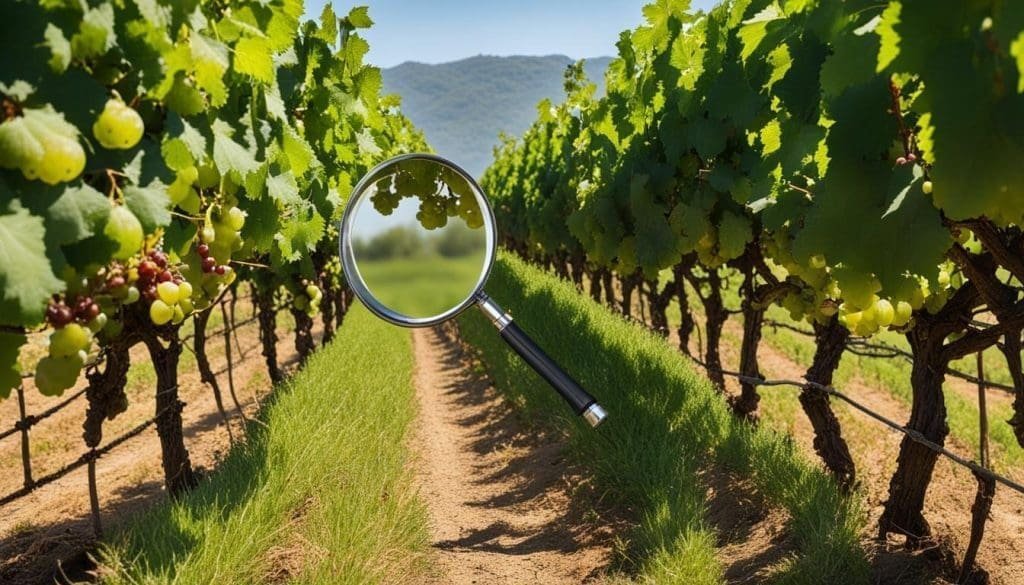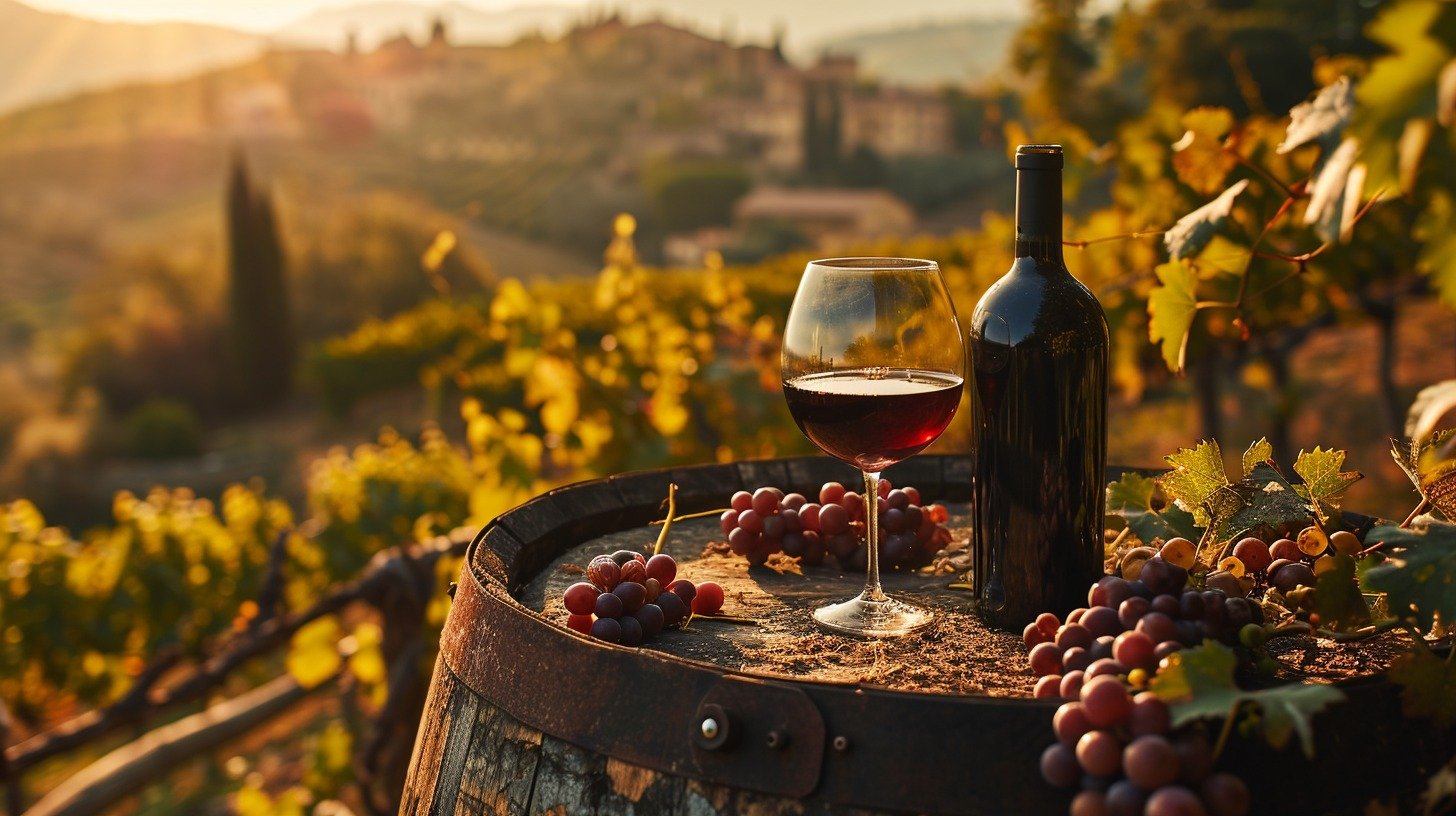Are you keen to learn about the nuances of Italian wine classification? Let’s take a squiz at the distinction between DOC (Denominazione di Origine Controllata) and DOCG (Denominazione di Origine Controllata e Garantita) wines, which are at the heart of Italy’s wine heritage. Wrapping your head around these terms is not just a bit of book-smarts; it’s essential for any true-blue connoisseur or anyone simply wanting to enjoy a top-notch drop.
DOC vs DOCG represents more than just acronyms on wine labels; they signify a world of history, tradition, and stringent wine quality standards that Italian vintners must adhere to. These classifications are not just a bunch of old cobbers; they were instituted to preserve the authenticity and lineage of Italian wine, setting the barbie high for wine categories globally. With DOCG wines having to jump through more hoops than their DOC counterparts, they end up wearing a numbered government seal as a badge of honour, ensuring you don’t end up with a furphy.
Whether you’re sipping on a doc wine or swirling a glass of the more strictly regulated docg wine, you’re partaking in a tradition steeped in history. So, let’s dive into this bottle of knowledge and uncork the differences to ensure your next Italian wine adventure is as rewarding as a day spent in the sun-soaked vineyards of Tuscany itself.
Key Takeaways
- DOC and DOCG are pivotal components of the Italian wine classification system, each with its own set of strict guidelines.
- DOCG wines undergo a more rigorous vetting process, including lower yields and lengthier ageing, ensuring a higher standard of quality.
- The introduction of the DOC in the 1960s and DOCG in the 1980s has been instrumental in preserving Italian wine heritage.
- Both classifications impact everything from the grape varieties to the regional growth boundaries, setting a high standard in wine categories.
- Understanding the wine labels will help you make informed choices and potentially discover a new favourite.
- Though DOCG signifies an elite status in wine history, DOC wines also offer a rich taste of Italy’s wine diversity.
Introduction to Italian Wine Classifications
The essence of Italian wine lays not just in the aromatic vineyards and seasoned barrels, but also in a well-structured classification system that reflects decades of oenological sophistication and reverence for tradition. The Italian wine classification system serves as a testimony to the country’s enduring commitment to maintaining and promoting the highest standards of viticulture and winemaking.
History of Wine Classification in Italy
Italy’s journey through wine history has been marked by an evolving narrative that intertwines with its cultural identity. In 1963, the Denominazione di Origine Controllata (DOC) was established, drawing inspiration from the French Appellation d’Origine Contrôlée (AOC). This significant move was pivotal in setting benchmarks for quality and authenticity in the Italian wine heritage, creating a legacy that would transcend generations and borders.
Overview of the Italian Wine Classification System
Italy’s approach to wine standards has given rise to a comprehensive wine classification system embraced across the global market. Encompassing more than just DOC, the system includes the elevated Denominazione di Origine Controllata e Garantita (DOCG) – a tier representing the pinnacle of quality and precise cultivation standards. In addition to these, the Indicazione Geografica Tipica (IGT) and Vino da Tavola (VdT) form a four-tiered hierarchy designed to guard the prestigious Italian wine classification.
| Classification | Description | Quality Indicator |
|---|---|---|
| DOCG | Highest quality wines with stringent production controls | Superior |
| DOC | Quality wines with regulated zones of production | High |
| IGT | Wines with regional authenticity and varietal recognition | Flexible |
| VdT | Table wines offering wide stylistic freedom | Variable |
These designations foster a deep respect for the terrains and traditional winemaking practices, ensuring the continued flourishing of Italian wine heritage. With every sip savoured, oenophiles around the world partake in the celebrated narrative of Italy’s winemaking achievements.
What is DOC Wine?
When exploring the world of Italian wines, the Denominazione di Origine Controllata, or DOC, stands as a beacon of tradition and quality. This certification is a testament to the stringent DOC criteria set forth to protect the heritage and integrity of Italian wine production. Embarking on a journey through Italian wine regions reveals a tapestry of famous DOC wines that evoke a sense of place and adhere to these revered production standards.
Criteria for DOC Classification
DOC classification is reserved for wines that adhere to strict regulations outlined by Italian legislation. These regulations include designated geographic areas for cultivation, specific grape varieties permitted for use, and detailed winemaking protocols—from vineyard yield limits to mandatory oak ageing lengths. Complying with these regulations ensures that each DOC wine is a genuine articulation of the region’s viticultural identity.
Popular DOC Wine Regions and Examples
Italy’s mosaic of wine regions contributes immensely to its worldwide acclaim, offering an abundance of styles that carry the esteemed DOC label. For instance, the rolling hills of Tuscany are synonymous with the Chianti DOCG, known for its ruby-red Sangiovese-based wines that are as delightful with food as they are standalone. Equally renowned is Piedmont’s Barbaresco, where Nebbiolo grapes manifest into some of the most prestigious wines in the world, exemplifying the calibre of Italian winemaking.
Below is a table that showcases some of the most illustrious DOC wine regions, along with examples of their signature wines:
| Italian DOC Region | Famous DOC Wines | Grape Varieties | Notable Features |
|---|---|---|---|
| Chianti | Chianti Classico | Sangiovese | Medium-bodied with cherry and earthy flavours |
| Barbaresco | Barbaresco | Nebbiolo | Robust tannins and scents of roses and anise |
| Soave | Soave Classico | Garganega | Light and crisp with a mineral finish |
| Valpolicella | Valpolicella Ripasso | Corvina, Rondinella | Velvety texture with notes of black cherry and spices |
Indulging in these wines offers a sensory journey through Italy’s profound enological legacy, adhering to the meticulous wine production standards that the DOC label guarantees. The next time you select a bottle of Italian wine, consider the depth of tradition and meticulous craftsmanship captured within each glass—courtesy of the DOC’s emblem of excellence.
What is DOCG Wine?
The pinnacle of Italian wine prestige is encapsulated in the Denominazione di Origine Controllata e Garantita, better known as DOCG. This certification represents the utmost commitment to quality assurance, enforcing the strictest of production regulations to ensure the esteemed status of renowned DOCG wines. Beyond the legacy of their exquisite taste, DOCG wines are crafted with an adherence to rigorous standards that reflect both tradition and exceptional viticulture.
The Rigorous Standards of DOCG
To guarantee the elite status of DOCG wines, these bottles undergo stringent assessments that cover every aspect of the wine-making process. The involved procedures are focused on meticulous quality control, from the careful selection of grape varietals to stringent monitoring of the vineyard practices. Key highlights include mandatory hand-harvesting techniques and stringent yield restrictions to ensure maximum flavour concentration and terroir expression.
Notable DOCG Wines and Their Unique Characteristics
Italy boasts an impressive array of DOCG wines, each renowned for their distinct wine characteristics that speak volumes of their geographic lineage. Here’s a glimpse into some of the most prestigious DOCG wines that Italy has to offer, along with the traits that render them unique.
- Barolo: Often described as the ‘King of Wines’, Barolo manifests a robust structure and complex flavours ranging from ripe berries to earthy truffles.
- Brunello di Montalcino: A true embodiment of power and finesse, this wine offers a rich tapestry of dark fruit notes harmonized with spice undertones.
- Chianti Classico: The heart of Tuscany is captured in this wine, known for its vivid cherry essence and hints of tobacco that evolve with age.
| Wine | Vintage | Characteristics | Aging Requirement |
|---|---|---|---|
| Barolo DOCG | 2016 | Ripe cherries, tar, roses, and truffles | Minimum 38 months, including 18 months in barrel |
| Brunello di Montalcino DOCG | 2015 | Dark cherry, plum, leather, and tobacco | Minimum 50 months, with at least 30 months in oak |
| Chianti Classico DOCG | 2018 | Red fruits, dried herbs, balsamic vinegar | Minimum 12 months in oak |
Comparing DOC and DOCG Wines
Embarking on a journey through Italy’s vineyards offers a tantalising exploration of viticultural prestige, where both DOC and DOCG classifications share the limelight. In this appraisal, we’ll discern the essential distinctions that set these esteemed badges of oenological excellence apart.
Key Differences in Production and Quality Control
In the realm of wine comparison, DOC and DOCG labels serve as benchmarks of inherent merit. The crux of the disparity pivots on production differences that govern the wine’s genesis. DOCG, epitomising the zenith of quality control, necessitates a meticulous approach to cultivation—quantified through reduced harvest yields, fostering a concentration of flavours. The longevity of cellaring also emerges as a salient point, with mandatory ageing that imbues these wines with complexity and poise. To illuminate the guidelines that differentiate DOC from DOCG, consider the table below:
| Aspect | DOC | DOCG |
|---|---|---|
| Yield Per Hectare | Higher Limits | Stricter Caps |
| Ageing Period | Minimum Required | Extended Duration |
| Quality Assurance | Regulated Standards | Taste Testing & Official Approval |
| Production Zone | Specific Regions | Highly Selective Areas |
Flavour Profiles and Terroir Influence
When it comes to the sensory tapestry unfurled by each glass, wine flavors are inextricably linked to the soul of the soil—the terroir. The DOCG designation is synonymous with a flavour profile that honours the sanctity of its provenance. This taste comparison is not merely academic; aficionados revel in the nuances, allowing the wine’s narrative to be shaped by the very earth it’s sprung from. A DOCG’s connection to its terroir is emphatic, broadcasting a resonance of place with every sip.

In essence, whether you sway towards DOC’s democratic charm or you’re lured by the aristocratic allure of DOCG, the sensory journey is enriched by understanding and appreciating the profound interplay between stringent standards and the lush regional landscapes.
Is DOCG better than DOC?
The Impact of DOC and DOCG on Wine Market and Consumer Choice
The intricate labels of DOC and DOCG wines are more than just symbols; they are powerful influencers in the wine market, shaping consumer behavior across Australia and around the globe. Their presence on a bottle can sway the decisions of oenophiles and casual drinkers alike, carrying with them a heritage of quality and the assurance of stringent production processes. This trust translates into consumer preferences, often guiding shoppers as they navigate through the sometimes-overwhelming task of selecting a wine.
How Labels Influence Purchasing Decisions
In a marketplace brimming with choices, DOC (Denominazione di Origine Controllata) and DOCG (Denominazione di Origine Controllata e Garantita) labels help to demystify the wine buying guide for many consumers. These certifications are a testament to a wine’s geographic authenticity and adherence to production quality—factors that are increasingly important to consumers. Whether it be a full-bodied red or a crisp white, the DOC and DOCG labels serve as a beacon for quality in a bustling wine market.
Tips for Selecting the Right Wine (DOC or DOCG)
For those looking to refine their wine tips, understanding the difference between DOC and DOCG classifications is essential. A DOCG designation usually points to a wine of high prestige, having met more demanding regulations. However, a DOC wine often represents excellent value, providing a high-quality experience without the higher price point often associated with its DOCG counterparts. Here’s a simple guide to help you when selecting wine:
| Wine Selection | DOC | DOCG |
|---|---|---|
| Quality & Authenticity | Controlled Origin | Controlled and Guaranteed Origin |
| Price Point | Generally more affordable | Tends to be higher priced |
| Availability | Wide and varied selection | More exclusive selections |
| When to Choose | Everyday enjoyment & wider exploration | Special occasions & refined tastes |
If you’re still unsure, consult with wine experts or in-store consultants. Their insights can be invaluable in matching your preferences with the right bottle, from the robust reds to the lightest of whites.
Appreciating the Diversity of Italian Wines
The fervour for wine appreciation goes hand in hand with an understanding of the country’s vast Italian wine diversity. Italy’s rich wine-making heritage has cultivated a multitude of wines that span a full spectrum from table wines to those crowned with DOC and DOCG statuses. The Italian wine framework offers not just a sip, but a deep dive into the land’s gastronomic history and culture.
From the rolling hills of Tuscany to the sun-kissed islands of Sicily, each bottle uncorks a narrative of the soil, climate, and traditions that define its origin. IGT and VdT labels, while not carrying the DOC or DOCG designation, encapsulate the innovation and experimentation of Italian vintners, broadening the horizons for wine enthusiasts. For the novice contemplating their entry into the world of wine, or the aficionado seeking that uncharted taste, Italy’s vinicultural mosaic is sure to offer a tantalising experience.
Here’s a toast to the Italian vineyards—the artistry behind each bottle should be as savoured as the wine within:
“In every bottle of Italian wine, there lies a story—a rich tale of tradition, dedication, and the pursuit of excellence that spans centuries. The sheer variety invites a journey of taste that goes beyond the label, cultivating an appreciation for every nuance of flavour that Italian wine has to offer.”
Whether you’re seduced by the robustness of a well-aged Barolo, charmed by the aromatic pleasures of a crisp Pinot Grigio, or intrigued by a local varietal that whispers of an ancient grape lineage—wine appreciation is an ever-evolving adventure, particularly when it comes to Italian wine diversity. So raise a glass, and celebrate the essence of Italy, encapsulated in every varietal, for an enriching and exquisite enological exploration.
Frequently Asked Questions About DOC and DOCG Wines
Navigating the rich landscape of Italian wines may pose as many questions as there are varietals. The Italian wine classification system in particular, showcasing its esteemed labels such as DOC and DOCG, delineates nuances in wine standards, affirming both the depth of tradition and the assurance of quality that connoisseurs and novices consider when selecting a bottle. In the pursuit of an exquisite wine experience, understanding the label differences, regional influences, and associated wine pricing is paramount.
What Are the Main Differences Between DOC and DOCG Labels?
The DOC label, standing for Denominazione di Origine Controllata, signifies adherence to specified production standards and regional practices. DOCG, or Denominazione di Origine Controllata e Garantita, adds an additional layer of quality assurance, often translating to docg cost reflecting the rigorous vetting process that these wines must pass through. These badges of authenticity not only guide consumers in wine quality recognition but also broadly influence the wine tastes and profiles we relish.
Is DOCG better than DOC?
DOCG (Denominazione di Origine Controllata e Garantita) is considered a higher quality tier than DOC (Denominazione di Origine Controllata). DOCG wines undergo more stringent regulations and quality checks, making them generally superior in terms of guaranteed quality compared to DOC wines.
Can I Determine the Quality of Wine by Its DOC or DOCG Status?
While the DOC and DOCG indications often signal a higher standard, wine quality also relies on the palate’s subjective interpretation. Each label carries the weight of Italian heritage and territorial integrity, punctuated by the terroir effect that profoundly shapes the sensory journey. Wine label identification is but a starting point; your taste ultimately arbitrates the true quality of the wine in your glass.
Are DOCG Wines More Expensive Than DOC Wines?
DOCG wines typically fetch a higher price in the market due to the stringent controls on docg quality, limited production, and often the intricate processes involved in crafting such wines. That said, doc affordability is multifaceted, with some DOC wines also occupying premium price ranges, indicating that both tiers offer a spectrum of options for various preferences and budgets.
How Does the Region Influence the Taste of DOC and DOCG Wines?
The concept of terroir—climate, soil, and landscape—plays a pivotal role in influencing the taste profile of Italian wines. Regional influence is not just a mere detail; it’s the very essence of what differentiates one wine from another. The nuances imbued by regional characteristics resonate within DOC and DOCG wines, giving each a distinct and memorable character.
What Food Pairings Work Best with DOC and DOCG Wines?
Pairing wine and food is an art form in itself. Whether it’s the robust flavours of a Barolo DOCG or the delicate aromas of a Soave DOC, there is a perfect match to enhance every meal. From hearty meat dishes to light seafood, the versatility of Italian wines ensures an endless array of food pairings to explore and enjoy.
How Should I Store DOC and DOCG Wines?
Preserving wine is crucial to maintain its integrity and flavour. Wine cellar tips often centre around proper temperature control, humidity levels, and limiting exposure to light. DOC and DOCG wines, with their nuanced complexities and ageing potential, demand attention and care in storage to allow their profiles to mature gracefully.
Are There Any Lesser-Known DOCG Wines That Connoisseurs Recommend?
Indeed, the realm of DOCG wines extends beyond the famous names. Wine connoisseurs frequently highlight rare docg wines that merit attention, each offering a unique exploration into less traversed vineyards and adventurous palates. These recommendations frequently embody the rich tapestry of Italy’s lesser-sung heroes.
How Can I Identify Authentic DOC and DOCG Wines?
In the pursuit of authentic wines, buying docg and DOC bottles should always involve scrutiny of the label. Look for the official seal, an indicator of provenance and quality, and familiarize yourself with the producers and regions that align with your taste preferences. Ensuring authenticity not only garners a genuine experience but also supports the dedicated artisans behind each bottle.
FAQ
What Are the Main Differences Between DOC and DOCG Labels?
The main differences between DOC (Denominazione di Origine Controllata) and DOCG (Denominazione di Origine Controllata e Garantita) labels lie in the level of quality control and production standards. DOCG wines undergo a more rigorous vetting process, including lower yield limits, longer ageing periods, and a taste evaluation by a government committee. Additionally, each DOCG bottle carries a numbered government seal to prevent counterfeiting.
Can I Determine the Quality of Wine by Its DOC or DOCG Status?
While the DOC or DOCG status can provide an indication of quality given the stringent standards they must meet, they are not the sole determinant of a wine’s quality. Each wine should be evaluated on its individual characteristics, including flavour, balance, and structure.
Are DOCG Wines More Expensive Than DOC Wines?
Typically, DOCG wines are more expensive than DOC wines due to the stricter production regulations, reduced yields, and enhanced quality control measures, which can lead to higher production costs. However, price can also be influenced by brand reputation, demand, and scarcity.
How Does the Region Influence the Taste of DOC and DOCG Wines?
The region greatly influences the taste profile of DOC and DOCG wines through the concept of terroir, which encompasses the region’s climate, soil, and topography. Regional influence contributes to the unique flavours, aromas, and character of the wine specific to its geographical origin.
What Food Pairings Work Best with DOC and DOCG Wines?
Food pairings depend on the specific characteristics of the wine. In general, DOC and DOCG wines pair beautifully with regional Italian cuisine that complements their flavour profiles. For example, a hearty Barolo DOCG wine might go well with rich meat dishes, while a crisp Soave DOC might be perfect with seafood.
How Should I Store DOC and DOCG Wines?
DOC and DOCG wines should be stored in a cool, dark place, ideally at a consistent temperature and humidity level. Bottles should be kept on their side to keep the cork moist, and away from strong odours or vibrations. Proper storage can help preserve the wine’s quality and prolong its lifespan.
Are There Any Lesser-Known DOCG Wines That Connoisseurs Recommend?
Yes, aside from the famous names, connoisseurs often recommend exploring lesser-known DOCG wines such as Gattinara, Carmignano, or Vernaccia di San Gimignano for their unique qualities and excellent representation of terroir. These can offer exceptional value and a new tasting experience.
How Can I Identify Authentic DOC and DOCG Wines?
Authentic DOC and DOCG wines can be identified by their distinctive labels, which include the DOC or DOCG logo, information about the wine’s origin, and a numbered government seal on DOCG bottles. Always purchase from reputable retailers to ensure authenticity.
Source Links
- https://www.winespectator.com/articles/what-s-the-difference-between-doc-and-docg-wines-in-italy
- https://www.abcfws.com/the-difference-between-doc-and-docg
- https://www.winespectator.com/articles/in-italian-wine-what-s-the-difference-between-doc-and-docg
User Review
( votes)Sip smarter, subscribe now!
Subscribe for gourmet tips, event updates, travel ideas, and a free e-book on Food Pairings. Start your journey to culinary and travel excellence!













